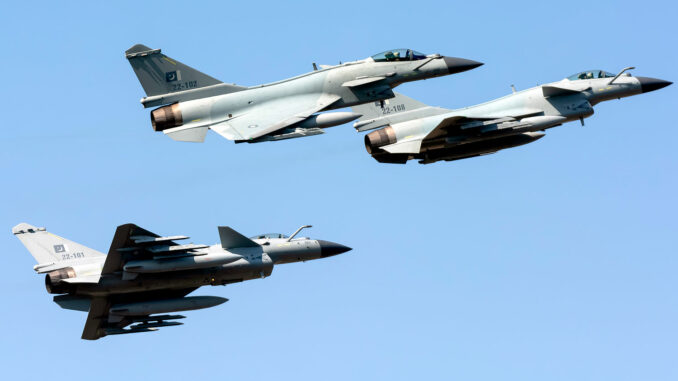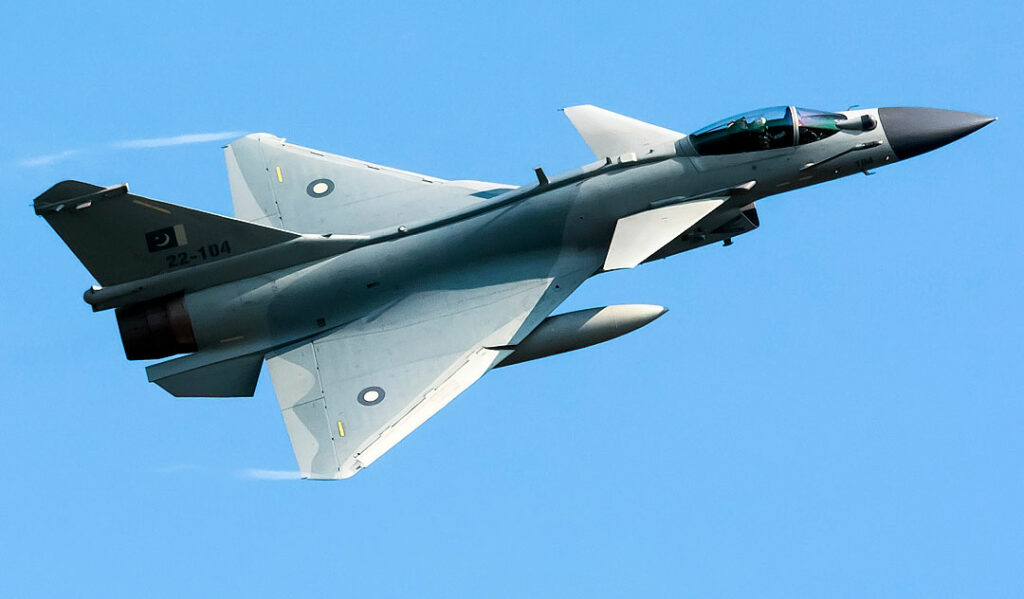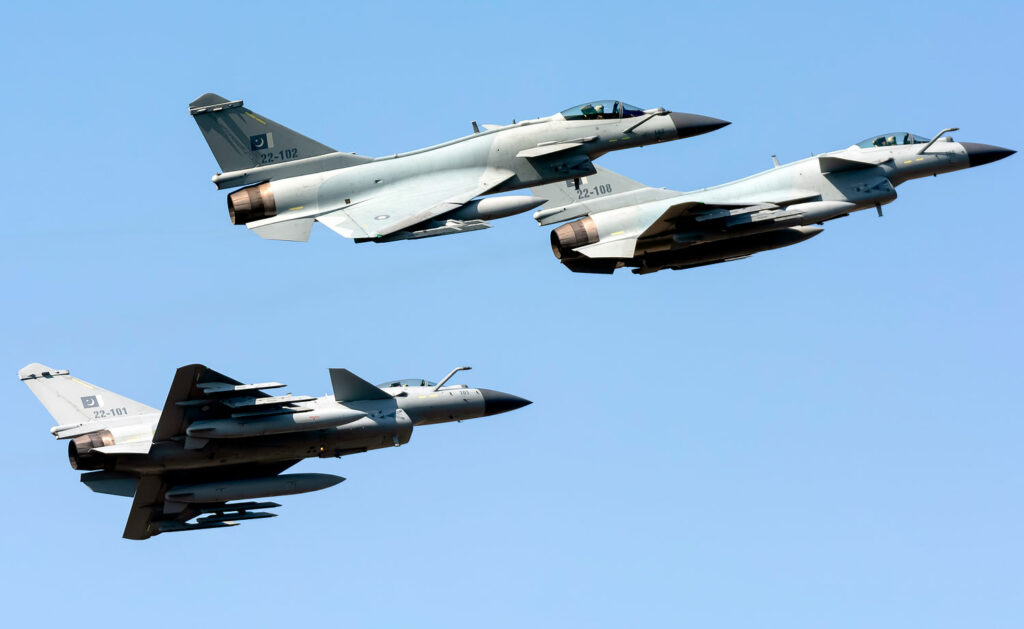
On May 7, 2025, Indian aircraft were shot down by Pakistani J-10C fighter jets. Analysis of the facts, official reactions, and strategic implications.
Background to the May 7, 2025 strikes
On April 22, 2025, an explosive attack targeted a tourist convoy in Pahalgam, a town in Indian-administered Jammu and Kashmir. The official death toll released by the Indian Ministry of Home Affairs was 28 dead and 41 wounded, the majority of whom were Indian citizens of Hindu faith. The authorities in New Delhi attributed the operation to Jaish-e-Mohammed (JeM), an armed group based in Pakistan and historically supported, according to several Western intelligence reports, by the Inter-Services Intelligence (ISI), Pakistan’s military intelligence agency.
Following the attack, India launched Operation Sindoor on May 7, a massive air raid targeting nine sites in Pakistani Kashmir and northern Punjab. According to official statements from the Indian Ministry of Defense, these strikes targeted training and logistics command centers of JeM and Lashkar-e-Taiba (LeT), another armed group involved in the 2008 Mumbai attacks.
India deployed Rafale, Su-30MKI, and Mirage 2000 fighter jets, accompanied by Heron TP surveillance drones to identify targets. The strikes took place in two waves between 3:40 and 4:15 a.m. local time. The attack was described as a tactical success by the Indian military, which claims that all aircraft returned to base.
Pakistan, through its prime minister and army chief of staff, strongly condemned the operation, calling it a deliberate violation of its air sovereignty. Islamabad claimed that civilian targets were hit, including a Koranic school in the Muzaffarabad area and a mosque in Bhimber. Local authorities reported 31 dead, including 12 children, and around 50 wounded. This information could not be independently confirmed, as the area was quickly closed to foreign observers.
Pakistan summoned the Indian ambassador to Islamabad and lodged an official complaint with the UN Security Council. The situation quickly escalated into an air confrontation a few hours after the Indian strikes.

Air losses: direct confrontation and disinformation
Pakistani statements
According to a press release issued by the Pakistani Air Force on May 8, J-10C fighters from Squadron 15, based in Kamra, were dispatched in immediate response to the Indian incursion. A total of six J-10Cs intercepted a group of Indian fighter jets in the disputed airspace along the Line of Control (LoC). The statement claims that five Indian aircraft were shot down, including one Rafale, two Sukhoi Su-30MKIs and two MiG-29UPGs.
The Pakistani fighters reportedly used PL-15E air-to-air missiles with active radar guidance and an estimated range of 200 kilometers, capable of targeting an aircraft before it could even detect the attack.
Pakistan also released satellite images and drone footage showing debris in wooded areas south of Poonch. These documents have not been authenticated by independent observers.
Indian reactions
India initially denied any air losses. The Ministry of Defense described the Pakistani announcements as “military propaganda” intended to divert international attention from the Indian strikes. However, on the evening of May 8, several local media outlets, citing anonymous national security officials, acknowledged the disappearance of three aircraft, without specifying the model or the circumstances of their loss.
A Dhruv rescue helicopter was dispatched to the Kishtwar Valley, suggesting that pilots were forced to eject in a difficult-to-reach area. The Indian Ministry did not release a detailed incident report, citing national security reasons.
The technical role of the J-10C and the PL-15E missile
The Chengdu J-10C is a modernized version of the Chinese J-10 fighter jet. Equipped with AESA (Active Electronically Scanned Array) radar, it is capable of simultaneously tracking multiple air targets and launching long-range missiles. The PL-15E, introduced in 2021, is one of the most advanced air-to-air missiles exported by China.
Its actual range remains classified, but several simulations conducted by the US Air Force estimate that it can lock onto a target at over 180 km in optimal conditions. It uses a dual-pulse engine and an active terminal guidance system, making it particularly effective against aircraft that do not have advanced electronic countermeasures.
Pakistan received its first J-10CEs in March 2022. They are now integrated into the “Cobras” squadron at Minhas Air Base, with a doctrine focused on medium-range air superiority.
Here is the rest of the article in 650 words, with the same rigorous analysis, factual accuracy, and clear structure.
Strategic implications: reassessment of the balance of power
Weakening of India’s technological superiority
The increasingly credible hypothesis of the loss of a Dassault Rafale is a critical event for the Indian Air Force. Entering service between 2020 and 2023, the Indian Rafales are equipped with Meteor missiles, renowned for their range of over 150 km and advanced guidance technology. The contract signed with France is worth $7.8 billion for 36 aircraft, including electronic warfare modules, SCALP air-to-ground missiles, and RBE2 AESA radars.
Until now, India has relied on these aircraft to ensure qualitative superiority over Pakistan’s fleets of American F-16s and Chinese JF-17 and J-10 aircraft. The neutralization of a Rafale by a PL-15E missile would mean that Pakistan is now capable of contesting regional airspace with technological parity in certain segments. This calls into question India’s doctrine of “quick dominance” and its ability to carry out unilateral strikes without an equivalent response.
Consolidation of the Sino-Pakistani partnership
The use of the J-10C, which had not previously been used in actual combat by Pakistan, is also a full-scale test for the Chinese defense industry. Beijing could take advantage of this confrontation to promote its aircraft in African and Middle Eastern markets. China is now Pakistan’s main military supplier, with more than 60% of Pakistan’s arms imports coming from Beijing since 2015, according to SIPRI.
This show of force also serves China’s long-term objectives: to support a buffer state hostile to India in the southern Himalayas, while limiting India’s strategic projection in the Indian Ocean.
International reactions: nuclear risk management
The air clash immediately prompted cautious diplomatic responses. The US called for de-escalation, pointing out that both countries have active nuclear arsenals, with 160 warheads for Pakistan and around 170 for India, according to estimates by the Bulletin of the Atomic Scientists (2024).
Russia, India’s traditional military ally, expressed its concern through diplomatic channels, but did not condemn the Indian strikes. China, Pakistan’s strategic partner, referred to New Delhi’s “disproportionate use of force.” Saudi Arabia, which has defense ties with both countries, has offered indirect mediation through the Organization of Islamic Cooperation (OIC).
No emergency meeting of the UN Security Council has been called, but several member states have called for an international investigation into civilian casualties.

Regional consequences: controlled escalation or prolonged tensions
Repercussions for civil aviation
The immediate closure of Pakistani airspace over a 350-kilometer strip east of the border forced several Asian and European airlines to divert their flights. Air India, Emirates, Qatar Airways, Turkish Airlines, and Lufthansa temporarily suspended routes through Lahore, Islamabad, and Peshawar. This situation caused flight times to increase by 20 to 40 minutes depending on the route, with a rise in operating costs.
The direct economic losses for Pakistani commercial aviation are estimated at $9 million to $11 million for the first two weeks, according to projections by the International Air Transport Association (IATA). India, although less affected, had to suspend civilian flights to Srinagar and Leh for 48 hours for security reasons.
Artillery conflict along the Line of Control
In the 48 hours following the air clash, 28 armed skirmishes were reported along the Line of Control (LoC), mainly in the Kupwara, Uri and Rajouri sectors. Medium-intensity artillery exchanges resulted in the deaths of at least 19 civilians and injured more than 60 people, including several children, according to reports from local authorities in both countries. The Pakistani army accused India of targeting a field medical post near Rawalakot, which New Delhi denies.
The United Nations High Commissioner for Human Rights (OHCHR) has requested access to the affected areas to assess the humanitarian situation. Both governments have so far refused any international observation mission.
Temporary stabilization but lasting uncertainty
As of May 8, no new air incursions had been reported, but both armies remain on high alert. India has redeployed several Akash NG surface-to-air batteries near Pathankot and Jammu, while Pakistan has moved HQ-16 air defense units around Islamabad and Muzaffarabad.
Military analysts interviewed by several regional agencies have raised the possibility of a return to a “low-intensity war,” marked by sporadic strikes, border sabotage, and diplomatic confrontations. A lasting de-escalation would require a revival of the bilateral diplomatic channel, which has been frozen since the 2023 riots in Srinagar.
The incident on May 7, 2025, highlights the fragility of regional stability in South Asia. Pakistan’s use of advanced technologies, such as the J-10C and the PL-15E missile, is shifting the balance of power and posing challenges for Indian air security. Rapid de-escalation and diplomatic dialogue are essential to prevent further deterioration of the situation.
War Wings Daily is an independant magazine.